Weather greatly impacts drone racing performance in various ways. Wind speeds above 30 mph can disrupt stability and control, while rain and snow may cause electrical failures, impacting aerodynamics. Temperature extremes affect battery life and motor efficiency, leading to unexpected challenges. Visibility issues from fog or low light conditions can increase crash risks, making navigation difficult. Proper lighting is essential for meeting obstacles during races. As a result, understanding weather conditions and adjusting strategies accordingly, like using waterproof drones or managing battery life, is key to maintaining performance. Stick around to discover effective ways to adapt to changing weather conditions.
Effects of Wind on Racing
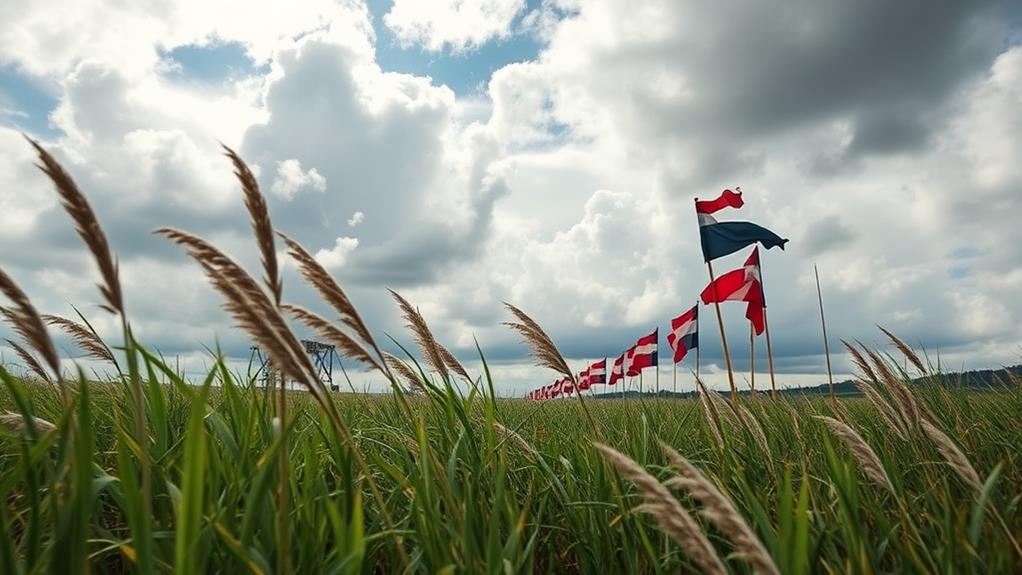
Wind poses a significant challenge in drone racing, often dictating the outcome of a race. When wind speeds exceed 30 mph, they can severely disrupt your drone's performance, leading to loss of control and potential crashes. Most racing drones, like the DJI FPV, are optimized for stable conditions, making gusty winds particularly problematic.
These winds create turbulence, pushing drones off their intended flight paths, which is especially challenging for novice pilots who may find it hard to compensate. To mitigate risks, it's vital to familiarize yourself with local regulations regarding drone racing in your area, as different regions may have specific guidelines for adverse weather conditions.
Moreover, wind direction plays an important role in drone handling. A headwind can slow down your drone's forward momentum, while a tailwind might accelerate it unexpectedly, complicating your race strategies. You'll need to adjust your approach based on these conditions to maintain control and speed.
To navigate these challenges effectively, continuous monitoring of wind conditions is vital. Sudden changes can lead to accidents, emphasizing the importance of real-time weather updates.
Impact of Precipitation
Weather conditions can quickly turn from challenging to perilous, especially when precipitation enters the equation. Rain or snow can pose serious threats to your drone's performance during racing events. For starters, moisture can lead to electrical failures, causing crashes and loss of control. Most drones aren't designed for wet conditions, making racing in the rain a risky endeavor.
Regular maintenance and pre-flight checks are vital to guarantee your drone remains airworthy in changing weather conditions, as comprehensive knowledge of drone functionalities can make a considerable difference in performance. Reduced visibility due to precipitation can also hinder your ability to navigate effectively.
Even light rain can introduce moisture on your drone's surfaces, adversely affecting aerodynamics and flight stability. These factors are essential for maintaining a competitive edge. The added weight from accumulated moisture can further complicate your control and maneuverability, leading to potential disqualification if performance dips below acceptable standards.
To mitigate these risks, effective weather forecasting and pre-race planning become fundamental. By keeping an eye on the forecast, you can better prepare for any unexpected weather-related disruptions.
Understanding the impact of precipitation helps you appreciate the importance of maintaining your drone and making informed decisions about racing conditions. Ultimately, being aware of these factors can greatly enhance your drone racing experience.
Temperature's Role in Performance
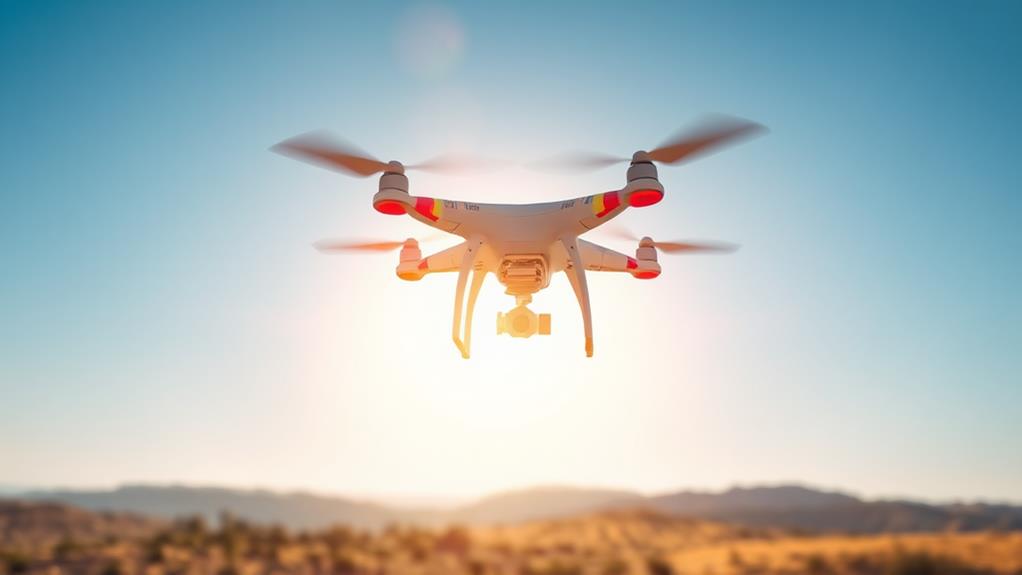
Temperature's Role in Performance
Temperature plays an essential role in drone racing performance, directly influencing battery efficiency and overall functionality. In cold conditions, you might notice increased risks of voltage drops, which can lead to shorter flight times. Additionally, 5G connectivity can help mitigate some of these issues by providing reliable communication for real-time adjustments during races.
When the temperature drops, longer downtimes between races become necessary. This pause allows the batteries and electronics to stabilize, preventing unexpected performance issues that can arise from rapid temperature changes.
Conversely, warm conditions can also pose challenges. High temperatures cause motors to work harder, which may lead to overheating. This overheating can severely impact your drone's speed and maneuverability, ultimately affecting your race outcomes.
Manufacturers typically set minimum operational temperature guidelines to help you maintain peak performance and avoid mechanical failures.
Visibility Challenges
Visibility is vital in drone racing, as it directly affects your ability to pilot effectively and safely. When faced with visibility challenges like fog, the situation becomes critical. A visibility index below 0.5 miles poses a high risk for racing, as FAA regulations require at least 3-mile visibility to guarantee safe operations.
Poor visibility can hinder your line-of-sight control, increasing the chances of crashes and collisions during intense races. Additionally, high humidity levels can lead to moisture accumulation on your drone, negatively impacting its aerodynamics and potentially causing malfunctions at high speeds.
Cloud cover can obscure sunlight, which makes it difficult for you to navigate and judge distances accurately—vital skills for high-performance racing. Moreover, rapid changes in weather can introduce unexpected visibility challenges that require you to adapt quickly.
Whether it's sudden fog rolling in or shifting cloud patterns, maintaining good visibility is essential for both safety and performance. In drone racing, every second counts, and being prepared for these visibility challenges can make all the difference in your racing success.
Importance of Lighting
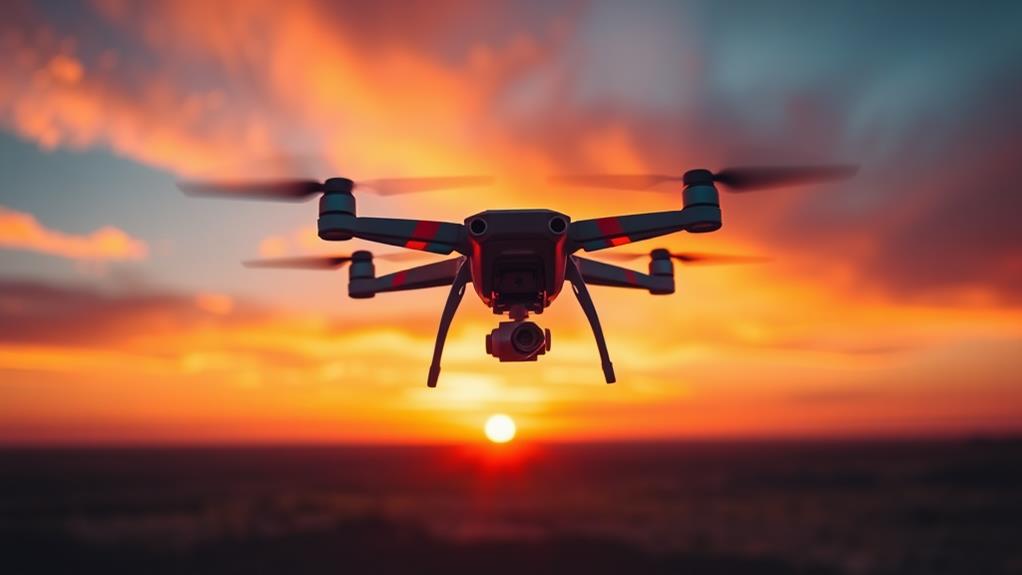
When the sun begins to set and dusk approaches, ideal lighting conditions become vital in drone racing. Good visibility allows you to navigate obstacles and maintain control of the drone during high-speed maneuvers. In contrast, poor lighting can obscure obstacles and make it difficult to judge distances, increasing the risk of crashes and hindering your performance.
Drones equipped with advanced lighting systems can greatly improve visibility for both pilots and spectators, enhancing the overall racing experience. In nighttime racing, you'll need to take into account additional lighting equipment to guarantee adequate visibility, which requires careful planning and adherence to local regulations regarding nighttime operations.
Moreover, studies show that lighting conditions can affect drone sensor performance. This aspect is important in racing environments, where split-second decisions matter. Proper lighting not only helps you navigate challenging courses but also optimizes your drone's sensors, assuring precision in every move.
Strategies for Weather Adaptation
Adapting to unpredictable weather is essential for maintaining peak performance in drone racing. Start with thorough Pre-Flight Weather Assessments, paying close attention to wind speed and precipitation probabilities. This proactive approach helps you optimize your racing strategy and guarantee safety.
Next, Adjusting Flight Plans is key. If you anticipate gusts or temperature shifts, modify your trajectory to maintain better control and stability during the race. Consider investing in Waterproof Drones, which can handle unexpected weather, like light rain, without significant performance loss.
Additionally, implement effective Battery Management Strategies. For instance, warming batteries before flights in cold weather can enhance performance and prevent voltage drops, which can be significant during high-stakes races.
Lastly, keep an eye on Visibility Considerations, especially during fog or low-light conditions. Confirming you can clearly see your surroundings is essential for preventing collisions and maintaining control.
Monitoring Weather Conditions
Effective monitoring of weather conditions is essential for achieving success in drone racing. Understanding wind conditions is important, as strong winds can disrupt flight paths and reduce stability, increasing the risk of crashes.
You must also keep an eye on visibility; factors like fog or cloud cover can hinder your control over the drone, making collisions more likely.
Precipitation intensity, such as rain or snow, can damage your drone's electronics, so monitoring these conditions is necessary for ensuring safe racing environments.
Additionally, temperature plays a significant role in battery performance. In cold environments, battery efficiency may drop, while high temperatures can lead to overheating, both affecting your drone flights.
Using weather forecasting tools allows you to anticipate changes in these conditions, enabling you to adjust your strategies effectively during competitions.
By keeping track of wind, visibility, precipitation, and temperature, you can optimize your drone's performance and reduce the risks associated with unpredictable weather.
This level of monitoring not only enhances your racing experience but also contributes to your overall success in the competitive landscape of drone racing.
Pre-Flight Weather Assessments
Pre-flight weather assessments are essential for ensuring a successful drone racing experience. As a drone pilot, you need to evaluate various weather factors that can greatly impact your racing performance.
Start with wind gusts; they can disrupt flight stability and control, making it vital to assess wind speed and direction before taking off.
Next, consider temperature conditions. Extreme heat can lead to battery overheating, while cold weather might reduce battery efficiency and cause critical voltage drops. You'll want to avoid conditions that could jeopardize your drone's performance.
Visibility is another key factor. Low-light conditions or fog can hinder your ability to navigate effectively, and racing regulations usually mandate a minimum visibility of 3 miles.
Don't forget to check precipitation forecasts. Rain or snow can compromise your drone's electronics, making most drones unsuitable for operation in wet conditions.
Community Insights and Resources
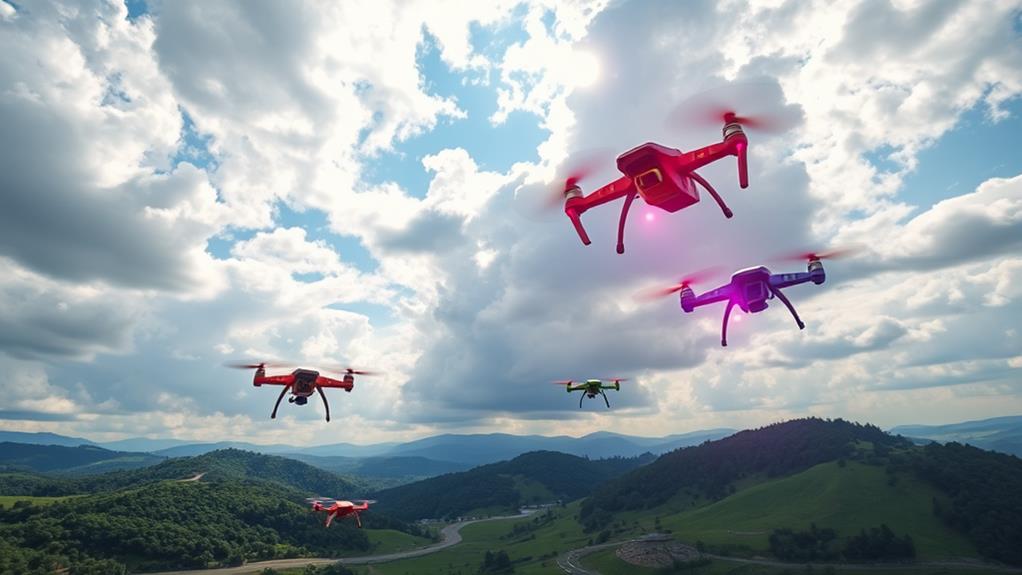
When it comes to maneuvering the challenges of drone racing in varying weather conditions, tapping into community insights and resources can be invaluable. Many experienced racers know that monitoring wind speeds is essential; even slight gusts can disrupt flight paths and stability.
Utilizing community resources, like UAV forecast apps and online forums, helps you access real-time weather updates that inform your choices on race day.
Precipitation risk is another key factor. Rain can damage sensitive electronic components and reduce visibility, increasing the likelihood of crashes. Engaging with fellow racers can provide tips on handling adverse conditions and enhancing your drone's weather resilience.
Additionally, understanding battery performance in extreme temperatures is significant. Hot weather can lead to overheating, while cold temperatures can diminish battery efficiency.
Community insights often include strategies for optimizing battery life under various conditions.
Conclusion
To sum up, weather plays a significant role in drone racing performance, influencing everything from wind speed to visibility. Just as a sailor adjusts their sails to harness the wind, you must adapt your strategies to the conditions. By understanding and monitoring the weather, you can optimize your racing experience. Embracing these elements not only enhances your skills but also deepens your connection to the sport, ensuring you're always ready to take to the skies, rain or shine.
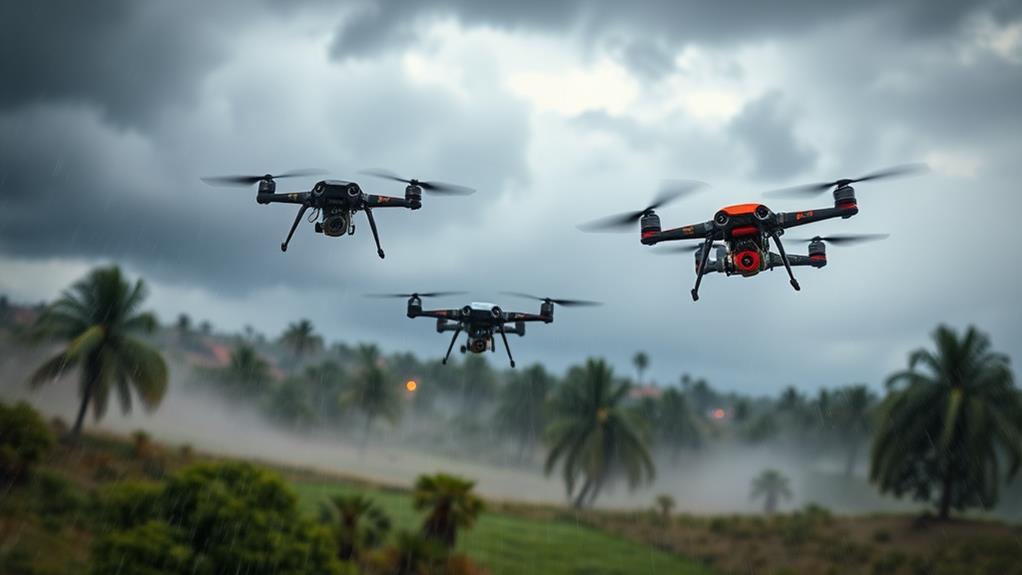
Leave a Reply